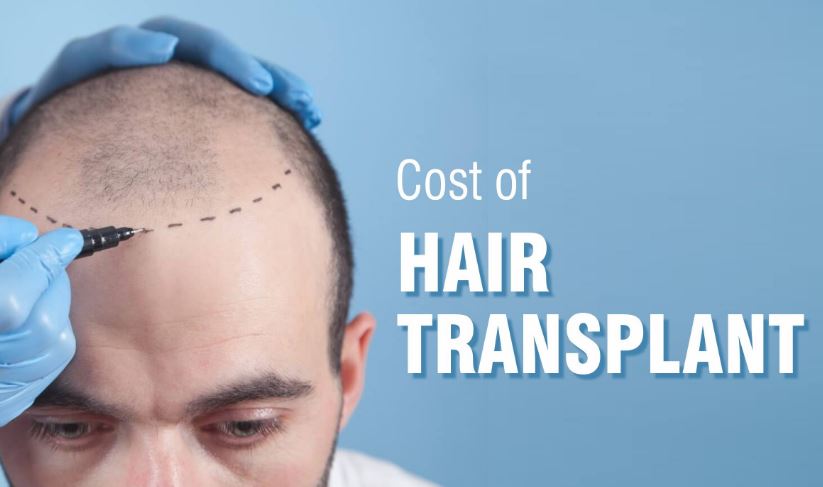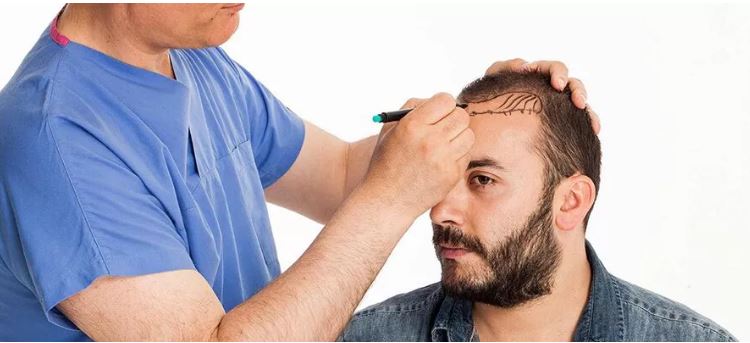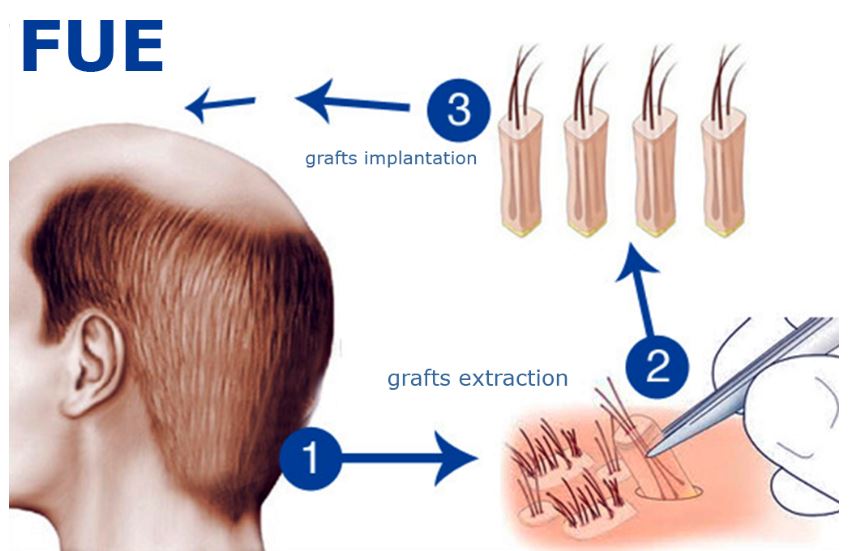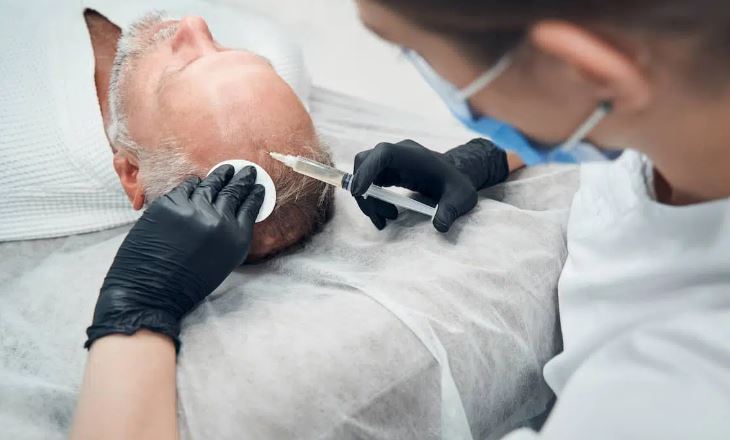If you’re experiencing a receding hairline, these transplants can help you to restore fullness. However, don’t let the shock cost you.
Learn more about the price, side effects, and more information about hair transplants.
Hair Transplant Cost 2024
Hair transplants had advanced from when they were first used in 1952. When the hair-plug technique was utilized, the results were not strictly natural.
When using old techniques, the significant gaps between hair tufts and apparent variations in the pattern of hair growth were evident when patients underwent an operation to transplant their hair. Thankfully, this is no longer the scenario.
Hair transplants of today appear natural and require a shorter time to heal and address issues like hair loss, bald patches or receding hairlines. However, the expense of hair transplants can be a significant factor limiting people.
The procedure could take thousands of dollars, between $2,000 and $20,000, contingent on the method utilized to do the transplant.
Your cost may be lower depending on:
- Your area
- How many grafts do you need
- The surgeon’s expertise
We’ll cover everything you should know about hair transplants, including hair transplant cost, the surgery process, possible side effects, top alternatives, and how to determine if this procedure is right for you in this guide. Let’s start with cost.
How Much does a hair Transplant Cost?
Hair transplants could be the best treatment for hair loss or baldness, but it’s not inexpensive. What does the cost of hair transplants cost?
The price for a hair transplant ranges from $2,000 to up to $20,000 per session. You will have to pay for these costs out of your pocket because most insurance companies view this as a cosmetic procedure.
That’s a wide price range. This is because there are so many cost factors in play when you get a hair transplant.
This includes everything from:
- Location of your transplant
- Your travel costs
- Number of grafts you need
- Skill level of your surgeon
- Your insurance coverage
- Any specials or discounts
Here’s more info on the factors that affect how much a hair transplant costs. And be sure to read to the very end.
it’ll save you a lot of time and headaches during the research process.
Hair Transplant Cost Factors
While the typical cost can be anywhere from $2,000 to $20,000 for hair transplants, Your price may be less or more based on these elements.
1. Number of Grafts:
The amount of hair grafts you receive in a session is probably the major cost component for a hair transplant procedure.
The surgeon will work with you to determine the number of hair grafts you’ll require to achieve the desired results.
The more grafts are priced higher in total but are generally priced less for each graft ($2-$5/graft). More minor grafts are less expensive overall but are priced higher for each graft ($5-$10/graft).
In one session, there is a max amount of transplants to be transplanted can reach approximately 4,500.
Each graft comprises a group of hairs ranging from 1-4. This means that you can expect approximately 6000 hairs transplanted within one or two sessions. But not every patient undergoes this procedure and needs the most significant amount of grafts that can be transplanted.
2. Location:
The area you’re living in will have a lot to determine the cost of your hair transplant. The cost of living within your region is an excellent indicator of how expensive a hair transplant may cost.
High living costs typically mean that the expense of the procedure is on the upper end and in reverse.
However, keep in mind that located in a region with limited surgeon options, you’ll have more competition and may discover that your doctor will charge a high or average amount.
If you’re located in an area where there are a variety of surgeons who specialize in hair transplants, You may be able to have less expensive hair transplants regardless of the higher costs of living. This is because there are more surgeons regularly performing the procedure.
In some instances, there might not be surgeons performing hair transplants in your region, and you’ll be required to travel elsewhere to get the procedure done.
3. Hair Transplant Technique:
Hair transplants today are done with one of two techniques: Follicular Unit Transplantation (FUT) or Follicular Unit Extraction (FUE).
Their costs are different, so pay attention to which type of procedure the surgeon you’re considering uses.
FUE (Follicular Unit Extraction) Technique:
FUE is a hair transplantation method which involves taking the individual hair follicular grafts from the back of the head. Follicular grafts are cut one by one through a small specialised machine and are removed. This process is tedious and takes a few hours to complete.
Hair grafts are also obtained from the chest or beard. The procedure is performed with local anaesthesia. The procedure leaves only small scars that are less than a millimetre. Therefore, stitching is not necessary. Recovery is quick in this way.
There are 2 different techniques of FUE hair transplant for graft harvesting:
- Manual FUE.
- Micromotor-assisted FUE.
Manual FUE uses hand power to extract the FUs. It was the first FUE technique in the earlier years of FUE. Later, manual extraction was largely replaced by the micromotor-assisted graft harvesting technique (mFUE). mFUE is the most commonly used FUE technique today and is adopted by more than 95% of the FUE clinics.
FUT (Follicular Unit Transplantation) Technique:
For harvesting grafts, a 10-20 cm long and 2-3 cm wide scalp strip is removed from the donor area and dissected into grafts (FUs).
FUT is the oldest method for hair transplantation; using a thin strip of the skin removes the scalp’s side part surgically. Hair follicles are separated into units, and the donor region is stitched.
FUT procedure leaves a visible cut on the donor’s region. Hair follicles are implanted by making holes or reception incisions within the treatment area and then placing hair follicles using forceps. The stitches can be taken off after 10 working days.
4. Surgeon Skill:
Suppose you’ve ever visited the cheapest salon and got poor haircuts. You know the importance of experience and skill to the price of the procedure, and hair transplants aren’t more or less the same.
The level of expertise of the surgeon who performs the surgery will impact how the procedure will cost. A skilled surgeon will deliver results of high quality that you will love. They also care to implant your follicles organically and appealingly.
That’s why experienced surgeons always charge more than surgeons with less experience or speed through the procedure without concern for the outcomes.
If you’ve heard glowing reviews about a reputable surgeon in your area that does excellent work, be aware that the cost won’t be inexpensive, but the outcomes are worth the price.
5. Insurance Coverage:
If you’re planning on submitting an insurance claim to your provider for a hair transplant to reduce the cost out of pocket and you’ll end up disappointed. Hair transplants are considered a cosmetic procedure that’s not medically required.
That’s 99.9 percent of the time (with the only exception of a severe injury that needs surgical scalp reconstruction).
your insurance policy will not pay for hair transplants. You’ll have to pay your expenses out of your pocket.
6. Travel and Recovery:
Be aware of the expenses of travelling and recovering. Suppose you cannot locate a surgeon who is qualified in your region or is planning to travel to get the procedure performed by a specific surgeon. In that case, you could incur expenses from gas, airfare, car rentals room, hotel rooms, and meals while travelling.
The time to recover is something you should be considered when calculating the cost also. It can take several days to recover from a hair transplant fully, so you’ll need some time off from work.
If you’re not working in a salaried job or cannot have days off paid, you should factor the days off from working into the hair transplant cost. Additionally, you’ll require pain medications and antibiotics for recovery, which may or might have to be paid for by insurance.
How Hair Transplants Are Done
After we’ve examined the average price of hair transplants and the variables that influence it, let’s take an in-depth review of the completed process.
This will allow you to understand what to expect should you decide to go ahead.
1. Prep and Numbing:
The initial steps in the process of undergoing a hair transplant are preparatory. The surgeon might require trimming or shaving the area of your scalp where the follicles are harvested. The scalp is cleaned and then numbed by a local anaesthetic.
If you’re going through FUT (follicular unit transplantation) procedure,
you might not require a haircut before the procedure.
2. Follicle Harvesting:
When the surgeon is sure that your scalp is numb, the surgeon will start removing hair follicles on your scalp, typically the top of your head.
If using the FUT method is utilized, a large strip of scalp is removed and then divided into smaller sections that can be transferred. The hairline will be sealed by stitching.
If the FUE method is utilized, the small motorized tube-like device is used to rapidly take tiny circular slices of the scalp, with four to five follicles within each section. This technique doesn’t require stitches.
3. Follicle Implantation:
After the hair follicles are taken from a healthy part of the scalp by FUT or FUE methods and then transplanted into the areas with hair loss, it could be your hairline, crown, or even a patch of hair loss across the scalp.
Tiny slits are cut through the scalp in the area you want to. Then the healthy follicles will be placed into the slits to begin growing to fill the surrounding area.
The procedure is repeated for the number of follicular units the surgeon removed in harvesting follicles.
4. Recovery:
After surgery, you’ll need a little more time to wait, and the results won’t be immediate. Most often, the hair transplanted falls out within a few weeks following the procedure and grows back out of the new follicle.
It could take several months to see the procedure’s full effects. Recovery from a hair transplant requires anti-inflammatory drugs, antibiotics, and painkillers.
Most patients have been able to return to working two to five days after. As you recover, you’ll have to be extra vigilant about taking care of your scalp and newly transplanted hair follicles.
Rubbing your head onto the pillow at night could cause friction and make hairs grow back. Showering should be performed with care, and your scalp should be cleaned to prevent infection.
How Long Do Hair Transplants Take?
Hair transplants can take a long time. You should anticipate spending between 5 to 8 hours in a medical center when you undergo hair transplants and even longer after recovering.
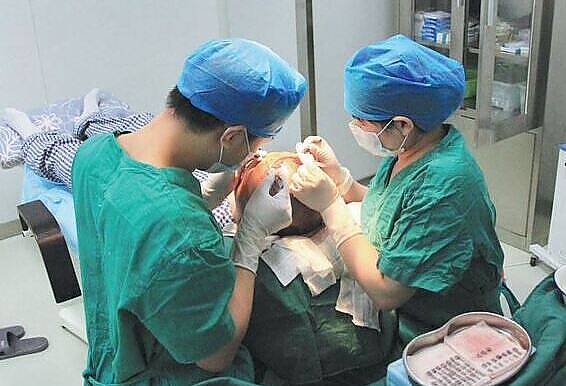
Recovery
The scalp could be susceptible after hair transplant surgery. It is recommended to use bandages for a few days. Your doctor might prescribe painkillers or the use of an anti-biotic to stop infection or anti-inflammatory medicine to decrease swelling.
The recovery time depends on the procedure performed, and FUE offers quicker recovery times.
In general, patients return to work within one week following the procedure. If stitches were used and removed, they’ll be done in 10 days.
Based on the American Society of Plastic Surgeons, Most transplanted hair will fall off within six weeks after the procedure.
The new hair growth should be evident in the recipient areas in a matter of months, and hair will grow by half an inch each month.
Do Hair Transplants Hurt?
Hair transplants typically don’t cause any harm; however, some patients claim they experience mild discomfort while undergoing the procedure. Since hair transplants are generally done under local anaesthesia, you’ll be alert and conscious of the procedure but not feeling it.
It’s not painful enough that most surgeons allow their patients to relax and watch films as the transplant is executed. A patient has described the sensation of being inserted while under a local anaesthetic.
“The sensation of the hairs being re-planted felt a bit like being prodded in the scalp with a biro, which was a small price to pay for reversing years of cruel shedding.”
The pain after surgery is more evident. However, the surgeon will give you anti-inflammatory medicine and painkillers to ensure your comfort while the transplanted follicles recover.
Possible costs after a transplant
In addition to the costs for the transplant procedure, there could be additional charges for recovery, such as:
- antibiotics
- anti-inflammatories
- pain medication
It is also possible to seek treatment in the event of complications from surgery, like infection, which may require paying for appointments with a doctor and other medicines.
Some surgeons also recommend minoxidil (Rogaine), a drug for hair growth after the transplant. It can be costly, and its effectiveness isn’t apparent.
Risks and considerations
The hair transplantation procedure is believed to be secure, providing a skilled and certified surgeon performs it. But, every surgery comes with risk.
The potential risks involved with hair transplants are:
- infection
- excessive bleeding
- inflammation of the hair follicles
- scarring on the scalp
- bumps on the scalp
- unnatural, patchy new hair growth
Sometimes, hair from the recipient’s area may disappear, a phenomenon called shock loss. Most of the time, this isn’t permanent, and hair will return with time.
There is also the possibility that the grafts may not “take,” so the procedure must be repeated.
Best Hair Transplant Alternatives
Not all people who desire stronger hair will opt for hair transplants. Some people find a hair transplant too expensive, and others prefer a nonsurgical method.
- Minoxidil (Rogaine): This is available to females and males without prescription.
- Oral finasteride (Propecia): Available for men by prescription only, this drug may encourage hair regrowth or slow down hair loss.
- Estrogen women who suffer from hair loss could get relief from oral or topical estrogen medication.
- Cortisone Topical and injectable cortisone could accelerate hair growth in certain people.
- Laser therapy: with low doses can be utilized to treat genetic hair loss and pattern balding in females and males.
Hair loss is due to medical conditions, like thyroid disorders, which can be reversed through treatment of the cause of the disease.
Are Hair Transplants Right for You?
With all this information in mind, are hair transplants going to be the right choice for you? That depends. Here’s what you should consider.
- The health of donor’s hair: You’ll need healthy, strong donor hair to be able to get hair transplants. If you’re experiencing hair loss in donor regions (usually on the back of the head), you might not be a suitable candidate for hair transplants.
- The female or male pattern of baldness: Women and men can gain from hair transplants; however, male pattern hair loss (androgenetic hair loss) is the most suitable patient for such a procedure. But, around 27% of transplants are carried out on women, So don’t rule out the possibility that you might have female pattern baldness.
- Type of hair: Coarse, light-coloured hair is the most suitable candidate for hair transplantation. Darker, fine hair needs more follicles transplanted to get the entire natural appearance. Remember this when you have dark, fine hair.
- The desired results are: Hair transplants help thinning and hair loss; however, they’re not entirely cured. The hair transplanted will fall off after the procedure, and anywhere between 10 percent or more of the transplanted hair will ultimately grow back. If you’re looking for an instant miracle, you have to be aware that hair transplants won’t be able to perform the task. If you’re hoping for less noticeable thinness and more fullness, you’re in the right place, and hair transplants may be the perfect solution.
- Budget: Hair transplants aren’t expensive and can cost anywhere between $2000 to $20K for the procedure. If you’re looking to save money, it might be worth considering getting fewer follicles to determine if you are satisfied with the outcomes. It is also possible to try one of the cheaper options mentioned in the previous paragraph.
Takeaway
The expense of hair transplants could be costly, and there’s no guarantee that the procedure will be successful. There are other aspects to consider when contemplating a hair transplant, like the expense of travel, the medications required following the process, and the time needed to recover.
Anyone interested in having a hair transplant must do thorough research on the topic and select an experienced and skilled surgeon who can carry out the procedure.
It is advised to discuss risks associated with surgery and recovery timeframes with the surgeon before undergoing the procedure.
FAQ’S About Hair Transplant
How long do hair transplants last?
Hair transplants are a long-lasting solution to hair loss when a skilled and certified surgeon does the operation.
Care for the hair transplanted appropriately after surgery is crucial to get the best outcomes.
What is the success rate of hair transplants?
Hair transplants are usually successful procedures. A study conducted in 2016 by Trusted Source interviewed those who underwent FUE hair transplants about three years after the surgery. The mean satisfaction score of the respondents was 8.3 out of 10.
When assessing success rates, people should consider that final results may take up to 18 months to show.
Is a hair transplant painful?
There is a tendency for people to experience minor pain for up to two days Source after the procedure for hair transplantation. However, pain medications and icing areas for 48 hours will reduce discomfort, and the FUT procedure can be more painful than FUE.
Is a hair transplant even worth it?
Hair transplants are typically more successful than over-the-counter hair restoration products.
But there are some factors to consider: Anywhere from 10 to 80 percent of the transplanted hair will fully grow back in an estimated three to four months. Like regular hair, the transplanted hair will thin over time.
Why do hair transplants fail?
A diverse range of factors can cause hair transplants to fail including graft rejection, eligibility for hair transplant, non-realistic expectations, poor post-hair transplant care, and inexperienced clinic.
Do hair transplants last forever?
A hair transplant generally can last the entire duration of your life, and the procedure is designed to last for a long time, and very rarely are they required to be redone. You’ll be able to observe the appearance of your new hairline as soon as your doctor finishes the transplant.
Which country has best hair transplant?
The 9 Best Countries for a Hair Transplant:
- Turkey. If you’ve been thinking about hair restoration treatment for a while, then it’s no surprise that Turkey is one of the best countries for a hair transplant. …
- Poland. …
- Hungary. …
- Thailand. …
- Germany. …
- Mexico. …
- India. …
- Malaysia. …
- The UK.
Can I wear a hat after a hair transplant?
Most people recommend waiting at least ten days before wearing a cap or cap. It takes between 7 and 10 days for the grafts you transplanted to establish themselves in areas of balding. Each follicular unit must remain in place without interference to prevent graft harm or guarantee long-lasting, optimal results.
Why is Istanbul famous for hair transplant?
The reason is that Istanbul has the best and most experienced hair transplant surgeons around the globe, in addition to the most up-to-date techniques for transplants in hospitals and clinics.
If you decide to undergo a hair restoration procedure in Istanbul and you’ll be sure that you’re in good hands.
Do hair transplants turn GREY?
Hair transplant surgery won’t change the color of your hair. In rare instances, the procedure could trigger premature greying of some transplanted hair, but this does not impact its general health or longevity. As the donor area begins to grey, the recipient’s zone will soon follow suit.
Is hair transplant successful for everyone?
Clinical studies show that about 85-95% of all implanted grafts easily grow in the transplanted area. This high percentage indicates that hair transplants are generally very successful. Some patients fear that, like other transplants, there will be a phenomenon of rejection called a graft.
Does Sun affect hair transplant?
To be safe, you should plan on avoiding direct sun exposure for two weeks after your procedure, and apply sunscreen (minimum SPF of 30) for up to four months. This doesn’t mean you have to hole up in your house for the entire time.
How long does the pain last after a hair transplant?
The discomfort and pain will be reduced between 48 and 72 hours after the surgery. The rise in pain after this time frame should prompt you to make an appointment with the office. Most of the pain you feel is derived due to pressure within your neck.
Is Minoxidil necessary after a hair transplant?
Using Minoxidil after a hair transplant procedure is not necessary. While some patients will have a hair transplant surgery to avoid using a medication, others just won’t just need it since they are not suffering from generic hair loss conditions.
What is the most successful hair transplant procedure?
FUE transplants can be as successful as conventional FUT techniques and have a graft survival rate of 90 percent. When using Robotic FUE technology, the percentage of success could be at or above 100 percent. The success rate is determined by the expertise, knowledge, and expertise of the physician performing the procedure.
Can we transplant white hair?
“Yes, gray hair can be transplanted as safely and successfully as the hair of any color.” A misconception about gray hair is that when hair turns gray it is no longer healthy hair. If this was true, then gray hair would not be suitable for transplant.

I am a beauty and hair specialist. I have been a hairstylist for nearly 4 years now. And love to explore different salons and their features. As a result, I decided to create a blog that tells people about the various salons and their pricing, services etc.
